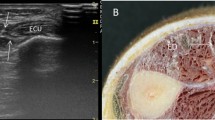Abstract
Purpose
There is no typical approach for decompression of forearm compartment syndrome, due to contradictory considerations regarding the characteristics of forearm anterior compartment deep fascia. The main purpose of this study was to determine how many fasciae should be opened to fully decompress the forearm anterior compartment. Further, the compliance of the deep anterior compartment was also investigated, to strengthen our results.
Methods
An experimental study of a laboratory model of acute forearm compartment syndrome was performed. A deep forearm injection of egg white was undertaken to create an acute forearm compartment syndrome in sixteen non-embalmed human forearms from six male and two female donors. The pressure in the superficial and deep anterior compartments was recorded four times, both before and after each fasciotomy and the compliance of the deep anterior compartment was calculated for each step.
Results
The first incision of the superficial lamina of the deep fascia was not sufficient to decrease the elevated compartment pressure in the superficial and deep anterior compartments. Whereas the pressures decreased to near-baseline levels, following the fasciotomy of the intermuscular septum observed posterior to the flexor carpi radialis. The last incision of the deep lamina of the deep anterior fascia had no noticeable impact. These observations supported the hypothesis of high compliance of the deep anterior compartment.
Conclusion
Two successive incisions were necessary to decompress the anterior compartment: the incision of the superficial lamina of the deep fascia and the incision of the intermuscular septum.





Similar content being viewed by others
Notes
C = Compliance, ∆V = Egg-white injection volume, ∆P = Pn–P4, Pn = Pressure measurement at step n, P4 = Pressure measurement at step 4, considered as the tare pressure, when all fasciae have been opened
References
Ardolino A, Zeineh N, O’Connor D (2010) Experimental study of forearm compartmental pressures. J Hand Surg 35:1620–1625. https://doi.org/10.1016/j.jhsa.2010.06.017
Chan PS, Steinberg DR, Pepe MD, Beredjiklian PK (1998) The significance of the three volar spaces in forearm compartment syndrome: a clinical and cadaveric correlation. J Hand Surg 23:1077–1081. https://doi.org/10.1016/S0363-5023(98)80019-1
Donaldson J, Haddad B, Khan WS (2014) The pathophysiology, diagnosis and current management of acute compartment syndrome. Open Orthop J 8:185–193. https://doi.org/10.2174/1874325001408010185
Fontes D, Clement R, Roure P (2003) Endoscopic aponeurotomy for chronic exertional compartmental syndrome of the forearm: report of 41 cases. Chir Main 22:186–196
Fröber R, Linss W (1994) Anatomic bases of the forearm compartment syndrome. Surg Radiol Anat SRA 16:341–347
Gelberman RH, Zakaib GS, Mubarak SJ, Hargens AR, Akeson WH (1978) Decompression of forearm compartment syndromes. Clin Orthop 134:225–229
Havig MT, Leversedge FJ, Seiler JG (1999) Forearm compartment pressures: an in vitro analysis of open and endoscopic assisted fasciotomy. J Hand Surg 24:1289–1297. https://doi.org/10.1053/jhsu.1999.1289
Kalyani BS, Fisher BE, Roberts CS, Giannoudis PV (2011) Compartment syndrome of the forearm: a systematic review. J Hand Surg 36:535–543. https://doi.org/10.1016/j.jhsa.2010.12.007
Liu Y, Maruvada S, Herman BA, Harris GR (2010) Egg white as a blood coagulation surrogate. J Acoust Soc Am 128:480–489. https://doi.org/10.1121/1.3442361
Masquelet AC (2015) Traitement chirurgical des syndromes de loge. EM-Consulte. https://doi.org/10.1016/S0246-0467(15)61736-6. http://www.em-consulte.com/article/978335/traitement-chirurgical-dessyndromes-de-loge
Ojike NI, Alla SR, Battista CT, Roberts CS (2012) A single volar incision fasciotomy will decompress all three forearm compartments: a cadaver study. Injury 43:1949–1952. https://doi.org/10.1016/j.injury.2012.08.006
Paturet G (1951) Traité d’anatomie humaine. Masson, Paris
Rouvière H, Delmas A (2002) Anatomie humaine descriptive, topographique et fonctionnelle. Elsevier Masson, Paris
Schumer ED (2004) Isolated compartment syndrome of the pronator quadratus compartment: a case report. J Hand Surg 29:299–301. https://doi.org/10.1016/j.jhsa.2003.10.021
Sotereanos DG, McCarthy DM, Towers JD, Britton CA, Herndon JH (1995) The pronator quadratus: a distinct forearm space? J Hand Surg 20:496–499. https://doi.org/10.1016/S0363-5023(05)80116-9
Standring S (2008) Gray’s Anatomy: The Anatomical Basis of Clinical Practice. Elsevier Health Sciences UK, London
Stecco C, Gagey O, Macchi V, Porzionato A, De Caro R, Aldegheri R, Delmas V (2007) Tendinous muscular insertions onto the deep fascia of the upper limb. First part: anatomical study. Morphologie 91:29–37. https://doi.org/10.1016/j.morpho.2007.05.001
Stecco C, Macchi V, Porzionato A, Duparc F, De Caro R (2011) The fascia: the forgotten structure. Ital J Anat Embryol 116:127–138
Stecco C, Tiengo C, Stecco A, Porzionato A, Macchi V, Stern R, Caro RD (2013) Fascia redefined: anatomical features and technical relevance in fascial flap surgery. Surg Radiol Anat 35:369–376. https://doi.org/10.1007/s00276-012-1058-0
Acknowledgements
Alexandra Bournazel for translation.
Author information
Authors and Affiliations
Corresponding author
Ethics declarations
Conflict of interest
Lionel Benamran and Alain-Charles Masquelet certify that they have no affiliations with or involvement in any organization or entity with any financial interest (such as honoraria; educational grants; participation in speakers’ bureaus; membership, employment, consultancies, stock ownership, or other equity interest; and expert testimony or patent-licensing arrangements), or non-financial interest (such as personal or professional relationships, affiliations, knowledge or beliefs) in the subject matter or materials discussed in this manuscript.
Rights and permissions
About this article
Cite this article
Benamran, L., Masquelet, A.C. A cadaver study into the number of fasciotomies required to decompress the anterior compartment in forearm compartment syndrome. Surg Radiol Anat 40, 281–287 (2018). https://doi.org/10.1007/s00276-017-1947-3
Received:
Accepted:
Published:
Issue Date:
DOI: https://doi.org/10.1007/s00276-017-1947-3




